This post originally appeared on the earliest version of this site, back in 2001, when it was hosted at Rutgers University (the old url was www.rci.rutgers.edu/~dmorton). Some body actually asked me about it recently (I dropped it years ago), so here it is, with updates.
Why have there been so many different, incompatible audio technologies? Why can’t manufacturers settle on one standard? I mean, what if every railroad had its own ideas about how far apart to put the rails? What if city planners couldn’t get together and agree about which side of the road we should drive on? Then what would we do?
Well, such confusion has been the norm for over a century in the audio-equipment business. There have been products that virtually (but never quite completely) dominated the market, such as the 78-rpm disk, the LP record, and the compact disc. But inventors and manufacturers have repeatedly introduced new formats to compete with them. Very often, that competition resulted in a sort of temporary cooperation, a melding of technologies. And while these two-headed hybrids rarely lasted very long, they made for some interesting listening. This page is devoted to these “fish with feet,” so to speak, these “missing links,” in evolutionary lingo.
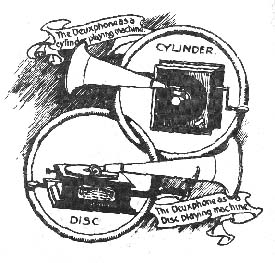 Cylinder to disc: The early days of the phonograph were marked by radically different ideas about the ‘best’ way to record and reproduce sounds. The technology was also being continuously improved, and inventors were struggling to find ways to avoid each other’s patented innovations. The results were numerous incompatible formats. Cylinders and disks came in different sizes, grooves were cut vertically (hill-and-dale) or horizontally, and there was no agreement about speeds. Some companies tried to accommodate the various standards by offering home players that were not tied to a particular brand of record. One example was the Deuxphone, a player for both cylinder and disc records.
Cylinder to disc: The early days of the phonograph were marked by radically different ideas about the ‘best’ way to record and reproduce sounds. The technology was also being continuously improved, and inventors were struggling to find ways to avoid each other’s patented innovations. The results were numerous incompatible formats. Cylinders and disks came in different sizes, grooves were cut vertically (hill-and-dale) or horizontally, and there was no agreement about speeds. Some companies tried to accommodate the various standards by offering home players that were not tied to a particular brand of record. One example was the Deuxphone, a player for both cylinder and disc records.
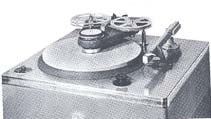 Disc to tape: Back in the early 1950s, radio stations were just beginning to consider tape recorders as part of their daily operations. Not every station was willing or able to invest in an expensive recorder right away, and most stations had a considerable investment in their disc-based “transcription” recording and playback equipment. The Presto Corporation, a pioneer in the tape recording field, offered this tape player attachment for its transcription turntables. The recorder mechanism was powered directly by the spindle of the turntable.
Disc to tape: Back in the early 1950s, radio stations were just beginning to consider tape recorders as part of their daily operations. Not every station was willing or able to invest in an expensive recorder right away, and most stations had a considerable investment in their disc-based “transcription” recording and playback equipment. The Presto Corporation, a pioneer in the tape recording field, offered this tape player attachment for its transcription turntables. The recorder mechanism was powered directly by the spindle of the turntable.
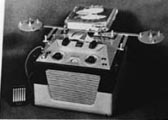 Cartridge tape to open-reel tape: Circa 1955, this contraption allowed a Fidelipak cartridge to be played on an ordinary
Cartridge tape to open-reel tape: Circa 1955, this contraption allowed a Fidelipak cartridge to be played on an ordinary
reel-to-reel tape recorder. The Fideipak was a precursor to the 8-track, initially marketed for background music applications, which had its greatest success in radio stations.
Pocket radio to dashboard: After the Introduction of transistor portables in the late 1950s, RCA tried to hawk a rig to allow a pocket-style transistor radio to be used in automobiles. It included an antenna and a special bracket for the dashboard.
 Living room to back seat: Lots of companies from the 1940s on offered products like the Miniverter, shown here. This allowed portable 110 volt appliances, such as tape recorders and television sets, to be operated from a 12 volt auto battery.
Living room to back seat: Lots of companies from the 1940s on offered products like the Miniverter, shown here. This allowed portable 110 volt appliances, such as tape recorders and television sets, to be operated from a 12 volt auto battery.
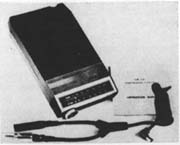 8-track to FM: The 8-track tape system introduced in 1965-66 spurred a great deal of interest in automotive sound systems. Suddenly everybody wanted AM, FM, tape, lots of extra speakers, and maybe even a cool “reverb”system to get that so-called concert hall sound. The problem was that most people could not afford to buy an all-in-one unit with AM, FM, and tape. Cars usually came with an AM radio, and under-dash tape players could be wired into the existing system. But what if you later decided you wanted FM? The solution was this plug-in unit, powered via thecar’s cigarette lighter, which provided FM sound through the 8-track player. Therewere of course also lots of plain FM adapters that mounted in a car and played FM through an AM radio.
8-track to FM: The 8-track tape system introduced in 1965-66 spurred a great deal of interest in automotive sound systems. Suddenly everybody wanted AM, FM, tape, lots of extra speakers, and maybe even a cool “reverb”system to get that so-called concert hall sound. The problem was that most people could not afford to buy an all-in-one unit with AM, FM, and tape. Cars usually came with an AM radio, and under-dash tape players could be wired into the existing system. But what if you later decided you wanted FM? The solution was this plug-in unit, powered via thecar’s cigarette lighter, which provided FM sound through the 8-track player. Therewere of course also lots of plain FM adapters that mounted in a car and played FM through an AM radio.
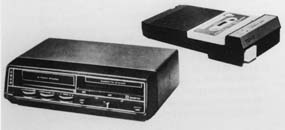 8-track to cassette and the old “let’s do both” solution: The 8-track came along at a pivotal moment in audio history, when there were an unprecented number of different car-audio options. For that reason, it was subject to the widest variety of adaptive strategies. By the early 1970s, cassettes were getting more popular, but did people throw out their 8-track tape collections when cassettes came along? Heck no! There were lots of ways to get around that problem. Shown here are two of them: a combination 8-track and cassette deck for the automobile, and a self-powered adapter to allow a cassette to be played in an 8-track player (good for older cars with 8-track players where the owner did not want to invest in a new cassette deck).
8-track to cassette and the old “let’s do both” solution: The 8-track came along at a pivotal moment in audio history, when there were an unprecented number of different car-audio options. For that reason, it was subject to the widest variety of adaptive strategies. By the early 1970s, cassettes were getting more popular, but did people throw out their 8-track tape collections when cassettes came along? Heck no! There were lots of ways to get around that problem. Shown here are two of them: a combination 8-track and cassette deck for the automobile, and a self-powered adapter to allow a cassette to be played in an 8-track player (good for older cars with 8-track players where the owner did not want to invest in a new cassette deck).